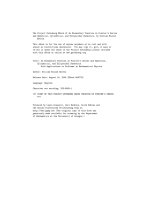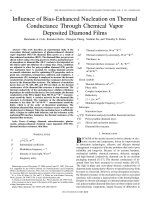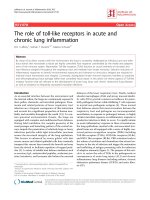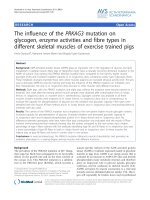Influence of CD137L reverse signaling on myelopoiesis in acute and chronic inflammation
Bạn đang xem bản rút gọn của tài liệu. Xem và tải ngay bản đầy đủ của tài liệu tại đây (5.72 MB, 193 trang )
i
INFLUENCE OF CD137L REVERSE SIGNALING ON
MYELOPOIESIS IN ACUTE AND CHRONIC
INFLAMMATION
TANG QIANQIAO
(B.Sc, Hons, NUS)
A THESIS SUBMITTED
FOR THE DEGREE OF DOCTOR OF PHILOSOPHY
ii
NUS GRADUATE SCHOOL FOR INTEGRATIVE
SCIENCES AND ENGINEERING
NATIONAL UNIVERSITY OF SINGPAORE
2014
iii
DECLARATION
I hereby declare that this thesis is my original work and it has been
written by me in its entirety. I have duly acknowledged all the sources of
information which have been used in the thesis.
This thesis has also not been submitted for any degree in any university
previously.
Tang Qianqiao
10 Jan 2014
iv
SUMMARY
CD137 is a costimulatory molecule expressed on activated T cells. The
signaling of CD137 into T cells upon ligation by its ligand, CD137L expressed on
antigen presenting cells (APC), can potently enhance the activation of T cells.
Reversibly CD137 can also induce signalling into APC via CD137L to promote
activation and proliferation. By investigating the role of CD137L on myelopoiesis
under inflammatory condition in vitro and in vivo, it was shown that CD137L reverse
signaling represents a novel and potent growth and differentiating factor for murine
myeloid cells during acute and chronic inflammation. In acute peritonitis and chronic
aging model CD137L reverse signaling promotes myeloid cell proliferation and
accumulation. Further investigations revealed the driving force behind the observed
myelopoiesis as CD137+CD4+ T cells and absence of CD137L reverse signaling
leads to accumulation of undifferentiated progenitor cells.
v
ACKNOWLEDGEMENT
First of all I would like to express my deepest thanks and appreciation to my
supervisor Associate Professor. Herbert Schwarz, who has provided impeccable
guidance on my thesis since the day I joined the lab. This project would not have been
finished without his genius vision and experience in immunology. Prof. Schwarz is
always supportive not only of my research work but also for oversea exposure. I am
grateful for him granting the freedom for such opportunities.
Very special thanks to Dr. Dongsheng Jiang, who was the mentor of my
honors project. Even after he left the lab, he continues to give me insightful
suggestion on experiment design. His pioneer work in infection model also formed a
solid base for my thesis.
I would also like to thank the following people for their work and support to
my thesis: Dr.Julia Martinez for her guidance and assistance on animal models; Mr.
Koh Liang Kai for his assistance in radioactive work and aging model; Ms. Akansa
and Dr. Sylvie Alonso for their work in bacterial infection; Dr. Richard Betts and Prof.
David Kemeny for their work in virus infection; Ms Angeline Lim and Dr. Veronique
Angeli for providing the aged mice;
vi
I am very grateful to National University of Singapore Graduate School of
Integrative Science and Engineering for providing me with a generous scholarship.
Ms. Irene Chuan is always supportive and helps me to resolve any problems
encounter in administrative or financial matters.
Last but not the least I would like to thank my parents for their love and
support throughout my life.
vii
TABLE OF CONTENTS
DECLARATION i
SUMMARY ii
ACKNOWLEDGEMENT iii
TABLE OF CONTENT v
LIST OF FIGURES xiv
LIST OF ABBREVATIONS xvi
CHAPTER 1 INTRODUCTION
1.1 Hematopoiesis 1
1.2 Myelopoiesis during steady state 2
1.3 Altered myelopoiesis during inflammation 3
1.4 Factors that influence myelopoiesis during inflammation 6
1.5 Biological function of CD137 8
1.6 CD137/CD137L bi-directional signaling system 11
1.7 Reverse signaling of CD137L on APC 13
1.7.1 Importance of understanding DC biology 14
viii
1.7.2 CD137L reverse signaling on human monocytes and immature DCs 15
1.7.3 CD137L reverse signaling on macrophages 17
1.8 Effect of CD137 on hematopoietic stem cells 18
1.9 Biphasic role of CD137L reverse signaling 19
1.9.1 Monocytes 19
1.9.2 B cells 20
1.10 Conflicting finding on CD137L reverse signaling 20
1.10.1 Anti-tumor effect 21
1.10.2 Autoimmune disease 22
1.10.3 Osteoclastogenesis 22
1.10.4 NK cells 25
1.10.5 Myelopoiesis 25
1.11 The role of T cell in maintaining myelopoiesis 28
1.11.1 Presence of T cells in bone marrow 28
1.11.2 Primary myelopoiesis 29
1.11.3 Extrameduallary myelopoiesis 30
1.11.4 Mechanism of T cell mediated myelopoiesis 30
ix
1.12 Immuneaging, inflammation and myelopoiesis 31
1.12.1 Mechanism and consequence of immuneaging 32
1.12.2 Intervention of immuneaging 33
1.13 Aim and scope 34
CHAPTER 2 MATERIALS AND METHODS
2.1 Mice 36
2.2 Infection of mice 36
2.3 Preparation of bone marrow cells and splenocytes 38
2.4 Isolation and culture of bone marrow monocytes 38
2.5
3
2.6 CFSE proliferation assay 39
H-thymidine proliferation assay 39
2.7 Phagocytosis assay 40
2.8 ELISA 40
2.9 Allogeneic mixed lymphocyte reaction 41
2.10 Isolation of T cells from splenocytes 41
x
2.11 Antibodies and flow cytometry 42
2.12 Immunohistochemistry 44
2.13 Transfer of in vitro activated T cells to WT mice 45
2.14 Isolation of Lin
-
progenitor cells from bone marrow and coculture of 45
CFSE-labeled bone marrow/ Lin
-
2.15 Cell Viability Count 46
progenitor cells with activated T cells
2.16 BrdU Incorporation 46
2.17 Microscopy 47
2.18 Colony formation assay 48
2.19 Statistics 48
CHAPTER 3 RESULT
3.1 CD137L reverse signaling in murine monocytes 49
3.1.1 CD137L reverse signaling induces morphological change in murine 49
monocytes
3.1.2 CD137L promotes survival and proliferation of murine monocytes 51
3.1.3 Costimulatory molecules are absent in CD137-treated monocytes 52
xi
3.1.4 DCs markers and MHC-II molecule are absent on CD137-treated 55
monocytes
3.1.5 CD137-treated monocytes have a low IL-12/IL-10 ratio 56
3.1.6 CD137-treated monocytes cannot stimulate T cells in an allogenic 58
mixed lymphocytes reaction
3.1.7 CD137L reverse signaling upregulates macrophage markers on 60
murine monocytes
3.1.8 CD137-treated monocytes have enhanced phagocytotic activity 62
3.1.9 CD137-treated monocytes exhibit cytokine profile similar to 64
macrophage upon stimulation by LPS
3.1.10 CD137L reverse signaling does not induce maturation in murine DCs 65
3.1.11 CD137L reverse signaling on murine monocytes is unique and distinct 70
from that by other members of TNF receptors.
3.2 CD137L reverse signaling induces myelopoiesis during inflammation in vivo 75
3.2.1 Percentage of myeloid cells during naïve state 76
3.2.2 CD137 is upregulated in bone marrow during infection 76
3.2.3 CD137
+
T cells are expanded in bone marrow during infection 80
xii
3.2.4 In vitro activated T cells that express CD137 can home to bone 86
marrow and other lymphoid organs
3.2.5 Activated CD4
+
through CD137L reverse signaling
T cells induce bone marrow cells proliferation 89
3.2.6 Activated CD4
+
T cells induce bone marrow cells and Lin
-
cell proliferation through CD137L reverse signaling
progenitor 92
3.2.7 Activated WT and CD137
-/-
production
T cells do not differ in GM-CSF 96
3.2.8 CD137 enhances primary myelopoiesis during peritonitis 99
3.3 CD137L reverse signaling maintains myelopoiesis during aging 105
3.3.1 Numbers of myeloid cells are increased in WT during aging, 105
but not in CD137
-/-
and CD137L
-/-
3.3.2 CD4
mice
+
3.3.3 Increased numbers of myeloid progenitor cells in the absence 112
T cells are increased in bone marrow of aged mice. 105
of CD137
3.3.4 Increasing colony forming units of myeloid lineage of 12-months 115
CD137
-/-
and CD137L
-/-
3.3.5 CD137
mice
+
CD4
+
T cells enhance myeloid cell differentiation of aged 118
xiii
Lin
-
progenitor cells
CHAPTER 4 DISCUSSION
4.1 Species difference of CD137L reverse signaling between human and murine 122
monocytes
4.1.1 Can CD137L induce DC differentiation in murine monocytes? 122
4.1.2 What cell types are the CD137-treated monocytes? 125
4.1.3 Is the macrophage differentiation signal truly through CD137L? 126
4.1.4 Underlying mechanism of species differences? 128
4.1.5 Other Concerns on species differences in CD137/CD137L biology 129
4.2 The role of CD137L reverse signaling in myelopoiesis during infection 131
4.2.1 What is the source of CD137 during infection? 132
4.2.2 Where do the CD137
+
4.2.3 What is the cell type responding to activated T cells during infection? 136
T cells come from? 134
4.2.4 Why is extramedullary myelopoiesis not affected by CD137L reverse 138
signaling?
xiv
4.2.5 Is CD137L reverse signaling the sole mechanism of the observed 139
myelopoiesis
4.2.6 Is CD137L reverse signaling absolutely dependent on CD137 141
crosslinking?
4.2.7 What is the significance of the biphasic role of CD137L reverse 143
signaling in myelopoiesis?
4.3 Role of CD137L reverse signaling in age-related myelopoiesis 146
4.3.1 Is CD137L a driving force of myelopoiesis during aging? 147
4.3.2 What is the role of CD137
+
4.3.3 Is CD137L necessary for transition from progenitor cells 150
T cells in age-related myelopoiesis? 148
to mature cells?
4.3.4 Implication of CD137L-mediated myelopoiesis during aging 152
CHAPTER 5 CONLUSION 155
REFERENCE 156
APPENDIX I 165
xv
APPENDIX II 166
APPENDIX III 167
xvi
List of Figure
Figure 1.1 Overview of hematopoieis.
Figure 1.2 Illustration of bidirectional signaling of CD137 and CD137L on APC and
T cells.
Figure 1.3: Illustration of reverse signaling of CD137L on monocytes, DCs and
macropahges.
Figure 1.4 Illustration of the changed balance between lymphopoiesis and
myelopoiesis during aging
Figure 2.1Calculation of absolute cell number. Figure 2.2 Calculation of absolute cell
number.
Figure 3.1.1 CD137-Fc induces morphological change of murine bone marrow
monocytes.
Figure 3.1.2 CD137L promotes survival in murine monocytes.
Figure 3.1.3 Expression of costimulatory molecules in CD137-Fc treated monocytes.
Figure 3.1.4 CD137 treated monocytes lack DCs marker and antigen presenting
molecules.
Figure 3.1.5 Cytokine production in CD137 treated monocytes.
Figure 3.1.6 Allogenic mixed lymphocytes reaction by CD137-treated monocytes.
Figure 3.1.7 CD137L reverse signaling upregulated macrophage markers in
monocytes.
Figure 3.1.8 CD137L reverse signaling upregulated the phagocytic activity of
monocytes.
Figure 3.1.9 CD137-treated monocytes exhibit property of macrophage.
Figure 3.1.10 CD137-Fc does mature murine DCs.
Figure 3.1.11 Morphological change, survival and cytokine productions of murine
monocytes treated by TNFR family members.
Figure 3.2.1 Myelopoiesis during steady state of WT and CD137-/- mice.
Figure 3.2.2 Increased CD137 expression in bone marrow during infections.
Figure 3.2.3 Identification of the CD137-expressing bone marrow cells.
Figure 3.2.4 Migration of activated, CD137-expressing T cells to the bone marrow.
xvii
Figure 3.2.5 CD137-experssing CD4
+
Figure 3.2.6 CD137-experssing CD4
T cells promote myelopoiesis in vitro.
+
T cells promote myeloid lineage proliferation
and differentiation of Lin
-
Figure 3.2.7 Expression of CD137 does not affect levels of GM-CSF expression.
progenitor cells in vitro.
Figure 3.2.8 CD137L reverse signaling enhances primary myelopoiesis during acute
peritonitis
Figure 3.3.1 Aged CD137-/- and CD137L-/- mice have reduced myelopoiesis in the
bone marrow compared to WT.
Figure 3.3.2 Increased number of CD4+ T cells in aged mice.
Figure 3.3.3 Increased number of myeloid progenitor cells in aged CD137-/- mice.
Figure 3.3.4 Increased number of colony forming units in aged CD137-/- mice.
Figure 3.3.5 Increased differentiation and proliferation of myeloid cells of aged WT
progenitor cells.
Figure 4.1 Species difference between human and murine cells in response to
CD137L stimulation in hematopoietic cells at different stages.
Figure 4.2 Model CD137L reverse signaling induces myelopoiesis during infection.
Figure 4.3 Model of CD137L-mediated myelopoiesis in aging animals.
xviii
List of Abbreviation
AML
Acute myeloid leukemia
APC
Antigen presenting cells
APC (dye) Allophycocyanin
BCG Bacillus Calmette–Guérin
BM Bone marrow
BMM Bone marrow-derived macrophage
BrdU Bromodeoxyuridine
CD137L CD137 ligand
CDP Common DCs progenitor
CFSE Carbosyfluorescein diacetate, succiniidyl ester
CFU-G Colony forming unit-granulocyte
CFU-GM Colony forming unit-granulocyte/macrophage
CFU-M Colony forming unit-macrophage
CLP Common lymphoid progenitor
CPM Count per min
DC Dendritic cell
EAE Experimental autoimmune encephalomyelitis
EDTA Ethylenediamine tetraaccetic acid
ELISA Enzyme-linked immunosorbent assay
FACS Fluorescence activated cell sorting
Fc Fc portion of antibody
FITC Fluorescein isothiocyanate
G-CSF Granulocyte colony stimulating factor
GM-CSF Granulocyte macrophage colony stimulating factor
HSC Hematopoietic stem cell
IDO Indoleamine 2,3-dioxygenase
xix
IFN Interferon
IHC Immunohistochemistry
IL Interleukin
ILA Induced by lymphocyte activation
i.p Intraperitoneal
IRB Institutional review board
i.v. Intravenous
KO Knockout
LCMV Lymphocytic Choriomeningitis Virus
LPS Lipopolysaccarides
MACS Magnetic activated cell sorting
MCP-1 Monocyte chemoattractant protein-1
M-CSF Monocyte colony stimulating factor
MDSC Myeloid derived suppressor cell
MEP Megakaryocyte-erythroid progenitor
MLR Mixed lymphocyte reaction
MPP Multipotency progenitor
MFI Mean fluorescence intensity
MLR Mixed lymphocyte reaction
NK Natural killer
NO Nitride Oxide
PBS Phosphate buffered saline
PBST PBS+0.05% Tween-20
PE Phycoerythin
PE-Cy PE-Cyanine
PercP Peridinin-chlorophyll-protein complex
PFA Paraformaldehyde
xx
RBC Red blood cell
ROS Reactive oxygen species
SD Standard deviation
TNF Tumor necrosis factor
TNFR Tumor necrosis factor receptor
TNFRSF Tumor necrosis factor super family
WT Wild type
1
Chapter 1 Introduction
1.1 Hematopoiesis
Hematopoiesis is the process of generating blood cells from hematopoietic
stem cells (HSCs). The rapid turnover of blood cells such as erythrocytes and
neutrophils requires a steady supply from the bone marrow, the primary
hematopoietic organ in adult mammals. A small pool of undifferentiated, self-
renewing hematopoietic stem cells are responsible of giving rise to all the downstream
blood cells. Classical viewing of hematopoiesis is usually composed of a cascade of
differentiation, starting from HSCs at the top of the pyramid and ending with terminal
differentiated cells that enter peripheral tissues. Except for T cells, B cells and certain
tissue specific macrophages, the relationship of the differentiation state and self-
renewing ability is reciprocal, meaning that as the more differentiated the cells are,
the lesser proliferative they are.
Moreover, only the rare population of HSCs retains the ability of
differentiating to all lineages of blood cells. The potential of committing to other
lineages diminishes as the cells progress through several stages of intermittent
phenotypes. For example, once the HSCs are committed to the fate of common
myeloid progenitor cells (CMP), they have lost the potential of lymphopoiesis. When
the stem cells have to make a decision of which lineage to commit to, they must
2
choose between the destiny of lymphoid lineage or myeloid lineage depending of the
signals received from the external environment.
Figure 1.1 Overview of hematopoieis . Differentiation of blood cells start with long
term HSCs and move down the cascade of a series of intermittent progenitor cell
types. HSC: hematopoietic stem cells. CLP: common lymphoid progenitor cells. CMP:
common myeloid progenitor cells. MDP: macrophage-dendritic cell progenitor cells.
CDP: common dendritic cell progenitor cells. CMoP: common monocytes-
macrophage progenitor cells. NK cells: natural killer cells.
1.2 Myelopoiesis during steady state
Myeloid cells consist of a variety of cells from both innate and adaptive
immunity, including neutrophils, macrophages, monocytes, myeloid dendritic cells
3
(DCs) and the less concerned eosinophils, mast cells and basophils (Fogg et al. 2006,
Geissmann et al. 2010). Understanding the underlying mechanism of myelopoiesis
during steady and disease state can significantly contribute to elucidation of the
potential pathogenic or regulatory role of each cell population.
1.2.1 DC
First identified in mouse spleen by Ralph Steinman in 1973 (Steinman 2007), DCs
are probably the most studied myeloid cells due to its central role of antigen
presentation. Early studies on monocytes biology suggest that monocytes are the
precursor of DCs when they migrate towards lymphoid tissue to present antigen to T
cells (Randolph, Beaulieu et al. 1998). However, many of these studies were
performed under the situation of inflammation and the origin of DCs during steady
state were not well identified. Adoptive transfer and in vivo labeling reveal that while
monocytes, macrophages and DCs may share a group of common myeloid progenitor
cells in the bone marrow term macrophage-DC progenitor (MDP), DCs precursors
become separated from the other two cell populations at the level of pre-DCs (Fogg
et al. 2006, Liu and Nussenzweig 2010). They have the plasticity of differentiating to
most of DCs found in lymphoid organ but not monocytes. Therefore, instead of being
the offspring of monocytes, DCs has its own precursor termed common DCs
progenitor cells (CDP). However, not all the DCs are of HSCs origin. Langerhans
cells, the skin-residing DCs, are proven to arise from yolk sac (YS) myeloid
4
progenitor cells and fetal liver monocytes early in the embryonic development. The
cells retain self-renewal ability and do not require a contribution of blood monocytes
for replenishment at steady state (Hoeffel, Wang et al. 2012).
1.2.2 Macrophage
Aside from DCs, studies also show that local macrophages population such
as microglia are resistant to radiation, indicating that some of the macrophages
populations are able to self renew and be independent of HSCs origin . Geissman
suggested that at least a few groups of myeloid macrophages, including microglia,
may arise from YS origin instead of monocytes at homeostatic state (Geissmann, et al
2010; Schulz, et al 2012). Indeed, studies show that myeloid progenitor cells from YS
arrive at the embryo and seed in the brain and skin, which gave rise to microglia. The
local microglia population is self-sustained throughout life without a contribution
from blood monocytes. When the blood-brain-barrier is not disrupted, local microglia
population is able to expand on its own (Ajami, Bennett et al. 2007). Moreover, a
group of macrophages expressing a high level of F4/80, the classical macrophage
marker, is found to originate independently from hematopoietic stem cells, suggesting
two routes of myelopoiesis (Schulz, et al 2012, Gomez Perdiguero, et al. 2013,
Kierdorf, et al. 2013).
5
Similary to microglia, Kuffper cells, peritoneal macrophages and splenic
macrophages were once thought to arise from blood monocytes after they extravasate
from circulation. However, studies showed that this scenario holds true only in the
condition of inflammation or when the local macrophage population is depleted. The
only macrophage population that is steadily replenished by blood monocytes is the
macrophages in lamina propria where there is a constant low degree of inflammation
(Yona, et al 2012). In conclusion, blood monocytes are dispensable for tissue DC and
macrophage population during steady state and they only transiently differentiate to
DC and macrophage when inflammation occurs.
1.2.3 Monocytes
As discussed above, monocytes were once considered the direct precursors of
both DCs and macrophages and replenished both populations after they extravasate
from the circulation. However, the identification of common DC progenitor cells
(CDP) in the bone marrow suggested that monocytes may have distinct progenitors
from DCs during steady state. Indeed although in the bone marrow the monocytes and
DC can be derive from monocytes-DC progenitor cells (MDP, the differentiation
program diverge at this stage (Hettinger, et al 2013). Downstream of MDP are two
distinct populations of progenitor cells: CDP and common monocytes progenitor cells
(CMoP). CMoP express Ly6C and exclusively give rise to Ly6C
+
blood monocytes
but not DCs.









